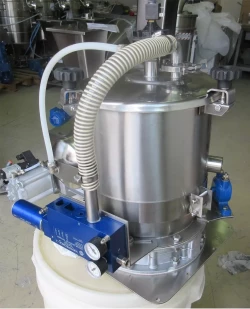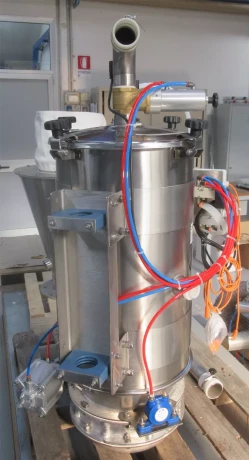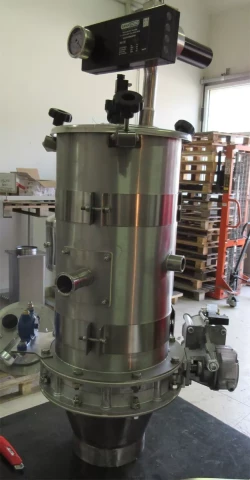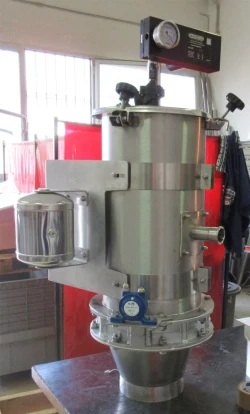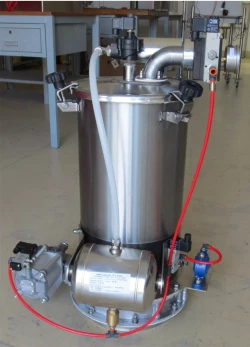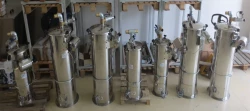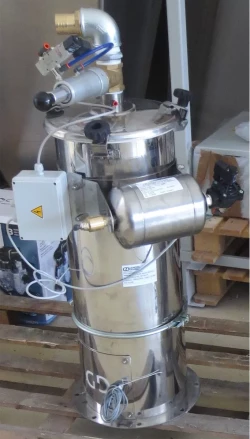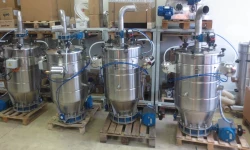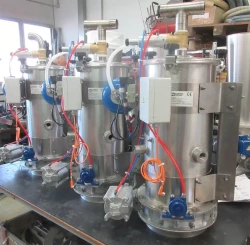Pneumatic Vacuum Loaders
series ATH, AJH, ATHY, AJHY, ATH-R, ATHY-R
Three-phases vacuum loaders series ATH
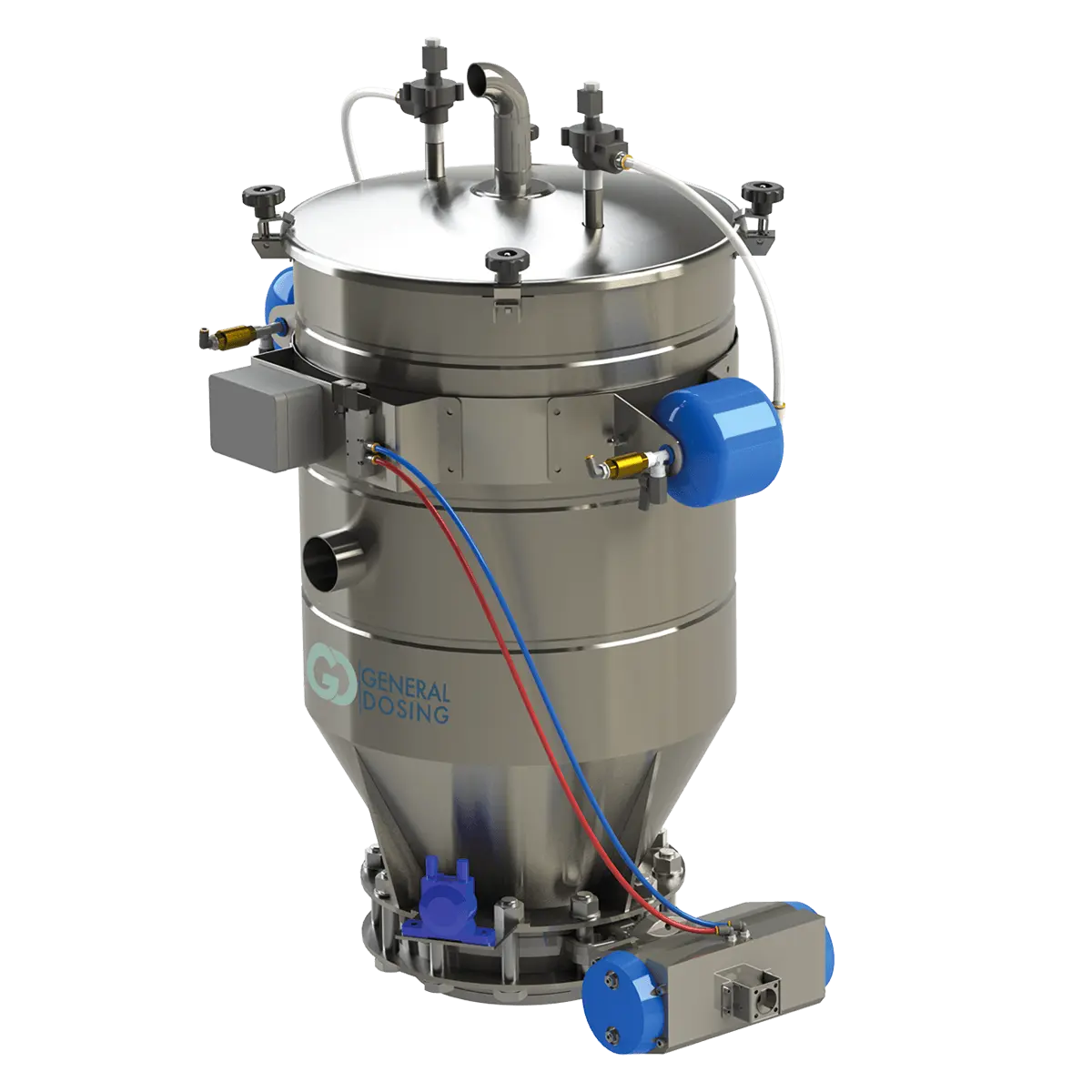
Vacuum loaders with Venturi generator series AJH
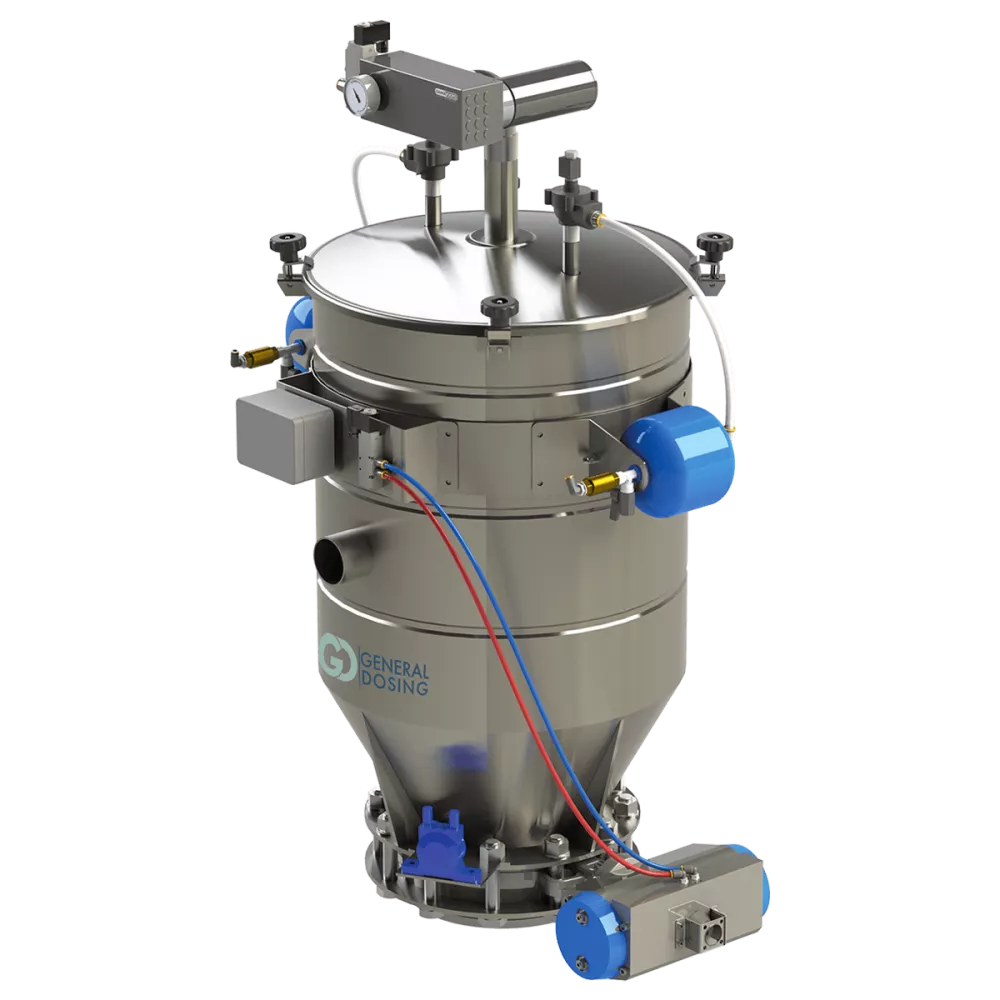
Continuous three-phases vacuum loaders series ATH-R
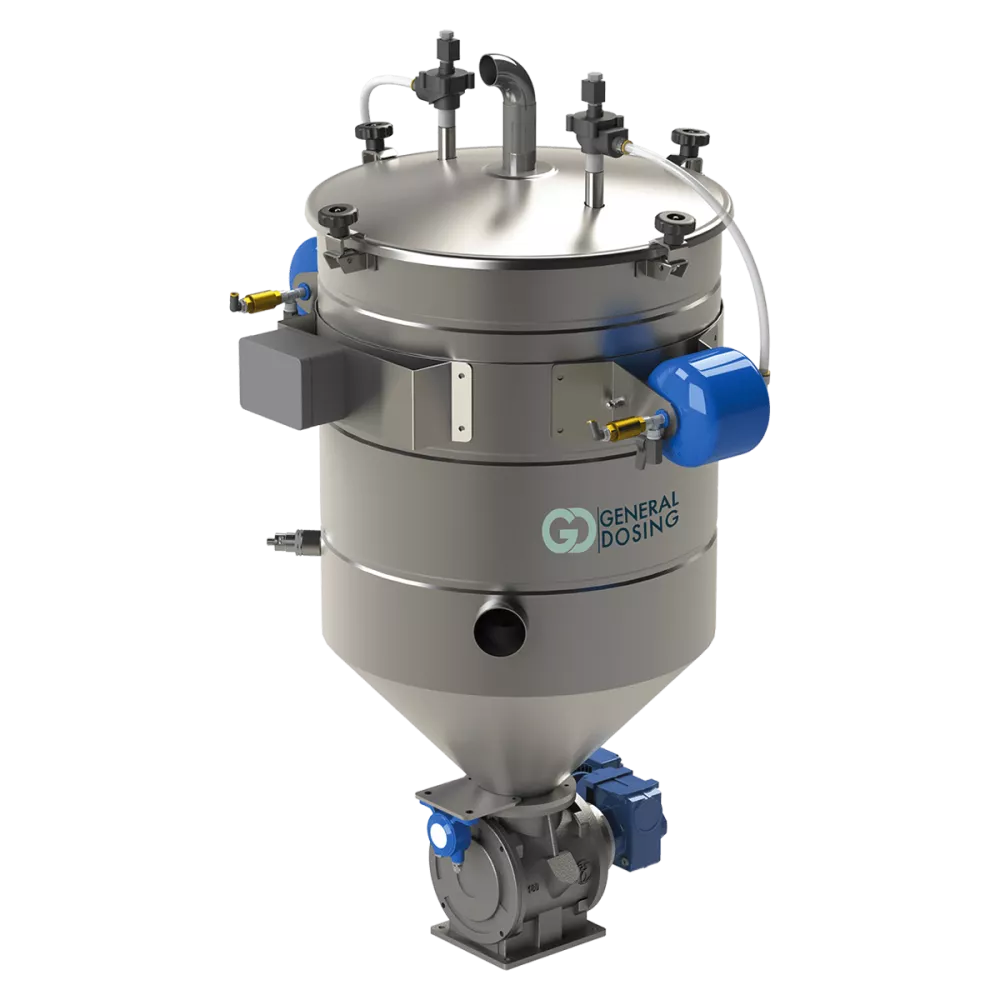
Gravimetric vacuum loaders series ATHY e AJHY
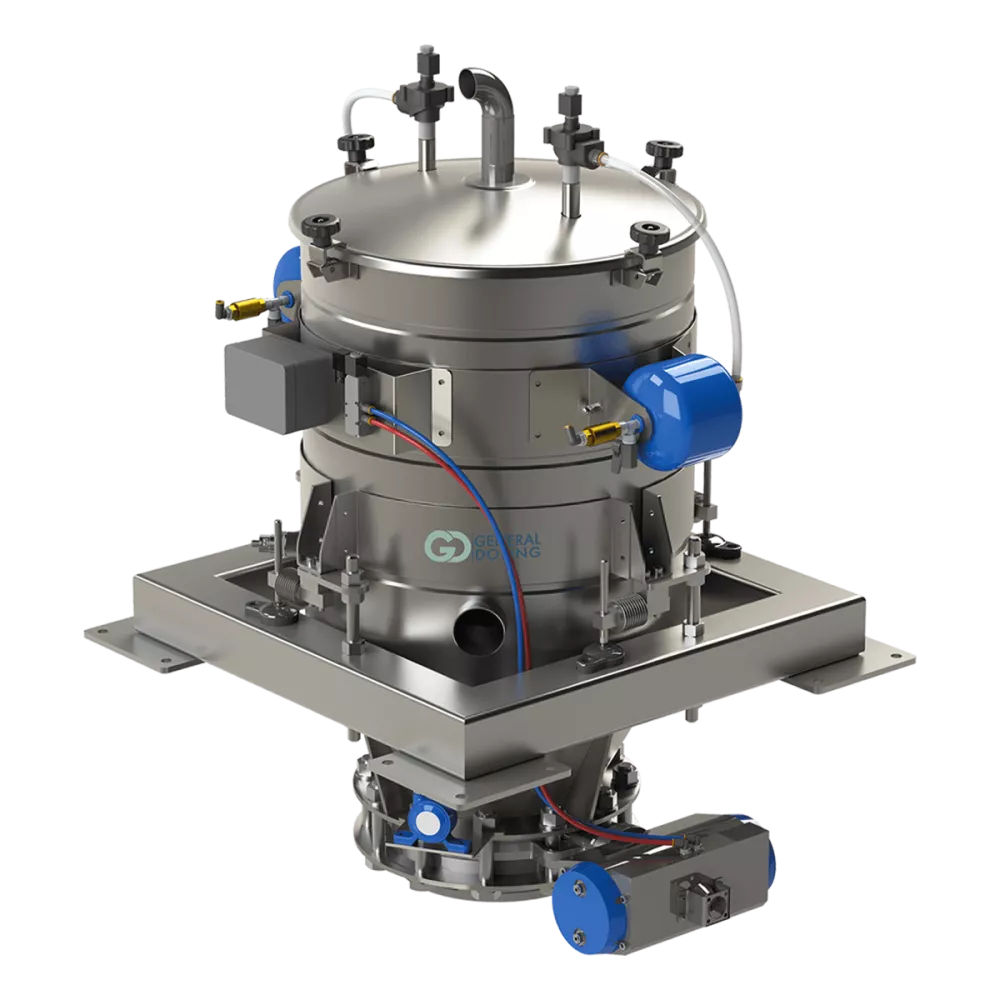
They are machines suitable for receiving solid bulk products, both granular and powder, conveyed with a pneumatic transport system in vacuum.
The pneumatic vacuum loaders ATH and AJH are receiving hoppers, cylindrical shaped, where it is created the vacuum by means of a suction unit series UATC,UATV,UAVL.
The product to transfer is sucked up from its storage container and it is conveyed in the receiving hopper through a dedicated piping line.
The transfer happens for cycles each one constituted by a loading phase and an unloading phase of the product.
Generally the pneumatic vacuum loaders ATH and AJH are used to feed production machines that have a continuous functioning. These machines have a feeding hopper above which it is placed the vacuum loader which provides to keep it always full. The vacuum loader is closed on top with a tight lid where it is installed a sleeve for the connection to the vacuum line. The lid is fixed to the receiving hopper by means of knobs, so it is totally removable. The receiving hopper of the vacuum loader is equipped with an inlet for the product entrance, installed sideways, and an unloading butterfly or clapè valve installed at the bottom. During the loading phase the valve stays closed in order to keep the vacuum inside the receiver. At the end of the loading phase the valve opens to unload the product and make it come down in the feeding hopper of the machine.
The loading phase can be defined by a time, or in a better way by using a maximum level sensor installed in the receiving hopper. The most used sensors are capacitive types, rotary level sensors, vibrating level switches to choose according to the product characteristics.
For poorly flowing products it can be installed a pneumatic vibrator close to the unloading valve useful to a complete and quick emptying of the receiving hopper.
Inside the vacuum receiver, just under the lid, it is placed a fabric filter that has the function to separate the incoming product from the air that conveys it. In this way the product is held by the receiver, where it builds up by gravity, without arriving up to the suction unit with the risk to create damages or possible malfunction.
The filter is always hit by the dust that creates during the transport and ends up staying on its surface. In the long run this problem tends progressively to saturate the filter that loses gradually its air permeability putting the pneumatic transport in trouble. So it is necessary to keep the filter always clean and efficient. To accomplish this necessity the pneumatic vacuum loaders ATH and AJH are equipped with a cleaning countercurrent unit, constituted by air-pressure nozzles controlled by a proper electrovalve. The nozzles are installed under the lid and push the air against the inside walls of the filter promoting the detachment of the dust particles. To increase the efficiency of the filter cleaning, mostly with particularly dust-forming products, it is possible to take place more cycles of air jet repeated in sequence. Doing so as well as air jets it produces also an intermittent mechanical action on the filter walls, which is another help to the detachment of the dust particles.
Removing the lid of the pneumatic vacuum loader it is possible to easily access to the filter and to the shooting nozzles for the periodic maintenance operations.
The logic management of the pneumatic vacuum loader provides that the filter cleaning is performed at every cycle during the unloading phase, to make the dust particles to come out together with the product.
One or more compressed air storage tanks, fed by to factory net and installed on the vacuum loader, provide always the air quantity necessary for an efficient filter cleaning.
The filters are available in different conformations: diaphragm, bag and star profile. In the vacuum receivers with a bigger dimension it can be installed also filters composed by multiple bags or cartridges. The choice is dictated by the necessary global filtering surface that depends other than the product, also on the air volume needed to ensure the transport capacity requested. The filters are made with fabric available in various compositions, texture and grammages. Shapes and compositions of the filtering fabric depend on the product to transport. For very fine powders are used fabrics coated in PTFE to increase the filtering efficiency.
The product inlet sleeve is placed under the lower limit of the filter and connects to the transport line. On the inside of the receiving hopper , in correspondence of the product inlet sleeve, there is a swinging clapè with dust-tight gasket that opens pushed at the passage of the incoming product and closes by gravity once the loading phase ends. Its function is to prevent the air generated by the jets of the filter cleaning to come out the product transport pipe creating dust in the environment.
The diameter of the product inlet sleeve depends on the hourly capacity requested and on the type of product to convey. Usually the inlet sleeve is installed perpendicularly to the receiving hopper. In presence of particularly fragile granular products it is provided a tangential inlet sleeve that produces a cyclone effect to avoid the particles to hit the inside parts of the hopper so as to shatter and damage themselves.
The pneumatic vacuum loaders ATH are used in combination with suction pump tree-phase units belonging to the family UATC and UATV to whom connect with proper pipes which constitute the vacuum line. The vacuum loaders AJS use vacuum generators series UAVL that are installed directly on board.
The pneumatic vacuum loaders ATH can be installed in battery each one connected to a single suction unit to constitute centralized loading system. In the centralized loading systems, the receiving hoppers are served one by one following a sequence based on the calling order of the machines to feed. The activation of each pneumatic loader happens by opening the automatic slide gate installed on the relative lids and connected to the vacuum line.
The pneumatic vacuum loaders ATH with their suction units UATC or UATV can feed machines with maximum flow rates around 3500 kg/h and cover transport distances until 50 meters.
For higher capacity it can be used pneumatic vacuum loaders series ATH-R that have an unloading rotary valve instead of a butterfly or a clapè valve. The pneumatic vacuum loaders ATH-R work continuously and the product loading occurs while unloading, so canceling the downtime typical of the functioning by cycles. The rotary valve is vacuum tight type and has to be dimensioned according to the capacity requested. The pneumatic vacuum loaders ATH-R can get to flow rates up to 9000 kg/h.
The pneumatic vacuum loaders AJH are normally used for small transports and when the required air flow capacity is so small to the point of not being economically convenient the use of a suction unit with three-phase pump. In this case the maximum productive capacity obtainable is 1000 kg/h and with transport distances until 20 meters.
The most used construction materials are stainless steel Aisi 304 and 316L, but it is possible to use also carbon steel on request.
The surfaces in contact with the product can be simply pickled or mirror-polished in case of poorly flowing products.
The gaskets are made in dust-tight rubber , such as SBR or NBR. They are available also with FDA certification on request.
The pipe used for the vacuum line can be stiff or flexible or even both types, based on the conveniences of installation. The stiff pipe are usually made of stainless steel while the flexible ones are in non-toxic and antistatic PVC with reinforcing spiral inside.
It can be also provided a suction probe made in tubular stainless steel, used to suck the product directly from the storage bags or containers.
The vacuum line can be fed by product intake hoppers series TPP, TPPW and TPPY that, thanks to their on board devices for the air flow rate regulation and automatic conveying line cleaning, ensure the best liability and efficiency of the transport.
Electrical control panels can also be supplied including software specifically designed accordingly to the requested functionality.
The operation logic, made with PLC, plans to set the times and the sequence of the phases that compose the pneumatic transport cycles, and includes also the automatic conveying line cleaning management when it is expected.
The pneumatic vacuum loaders series ATH and AJH are available also in the gravimetric version (series ATHY and AJHY ). In this setup the receiving hoppers are equipped with outer supporting brackets that allow the installation on load cells. The load cells are off-center or flexion type, made in aluminium or in stainless steel with protection grade up to IP67, available also with Atex certification when requested.
The pneumatic chargers ATHY and AJHY allow to transfer a defined quantity of product with better accuracy than the one that can be obtained with timed cycles or with a filling level sensor. The logic applied in this case is the one of the loading by sum of weight: at the start of the pneumatic transport cycle the system resets the weight on the scale(tare) and it follows the progressive increase until the achievement of the set quantity, that determines the end of the loading phase.
With pneumatic vacuum loaders ATHY, ATHY-R and AJHY it is possible to make a batch dosing of the product, unloading a preset quantity. In this case the batch logic applied is by difference of weight: at the receiver unloading start the system measures the total weight and it follows its progressive decreasing. The unloading phase ends once subtracted the quantity set.
The pneumatic vacuum loaders ATH and ATHY can be certified Atex 21/22 and Atex 21/21.

